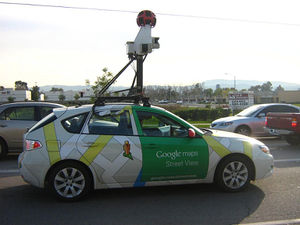Template:Autonomous vehicles
Contents
Autonomous Vehicles
Last Revised: March 29, 2018
Author: Christopher Fox-Strauss
Topic Editor: Dr. Peter Saundry
Background
The need for smarter, safer cars is evident. With a population almost entirely dependent on self-owned transportation, cars are a necessary risk. With nearly 40,000 fatal car crashes in 2015 alone in the U.S, driving is by far the most danger activity we participate in everyday[1]. However, 81% of all crashes in the U.S are a direct result of human error[2]. Distractions like phones and radio, along with physical factors such as eyesight and fatigue, plague drivers on the roads. Synonyms for AVs include: self-governing, self-ruling, self-determining, independent, sovereign, free, driverless, self-driving, or unmanned.
5 Levels of Vehicle Autonomy
- Level 0 (No Automation) – All tasks preformed by human operator.
- Level 1 (Assisted) – The vehicle assists the human driver with some tasks.
- Level 2 (Partial Automation) – The vehicle preforms multiple tasks for the human while the human still remains vigilant and attentive to the environment.
- Level 3 (Conditional Automation) – The automated system preforms most tasks, but the human must be able to resume full control of tasks.
- Level 4 (High Automation) – The vehicle controls all tasks, and the human is not required to control any tasks.
- Level 5 (Full Automation) – The vehicle controls all tasks, even without a human present.
Pros
Aside from saving lives, AV (autonomous vehicles) pose to save massive insurance costs, commuting times, police resources, parking space, and pollution to name a few. Annual medical costs associated with car accidents tops $23 Billion[1]; and insurance agencies should see a direct relationship between the number of crashes and their medical pay-outs. With a highly sophisticated network of computers communicating with one another, the possibilities of efficiency seem endless. Companies like Uber and Lyft could maximize efficiency to ensure every user has a car on time and few cars are left idle. Police could re-allocate resources to keeping cities safe from theft and crime, rather than pooling valuable time and money reporting and accessing accidents. Pollution would drop as the efficiency of these vehicles causes a downward shift of the number of vehicles required.
Cons
While this sounds like a utopia of human convenience and safety, some see a darker side. The first hurtle economists point out, is the same plight the electric car industry faced a decade ago (and still only constitutes 2% of the international vehicle market)[3]. The law of supply and demand would suggest that only those with the means to buy a driverless car, estimated to cost a minimum of $100,000, will be supplied with these vehicles. Until the technology comes down to a competitive price with standard, conventional cars, the likelihood of AV domination is many decades away. Another economic complaint would be that as soon as a company is able to roll out a price-competitive AV model, the company will posses a near monopoly on the industry. The further worry is that this company will be Google, leading to even greater and more rapid growth and cornering in nearly every market.
From a technological concern, many worry that with a highly integrated system, domestic and international terrorism in physical and cyber attacks would target the grid. A grid collapse or even small bump could cause tremendous damage, confusion, and delays, as the entire transportation system could be effectively off-line. Even system failures, such as the Spanish train accident of 2013, show the fragility of some systems; as well as the danger of complete reliance. Additionally, the current technology is nearly useless in mild to heavy rain. The current generation of laser sensors are easily thrown off and faulty during poor visibility situations- likely even worse than human eyes[2].
The Future
Despite these harsh criticisms, and heavy skepticism of computer reliance in one of the last mainly-analog facets of technology, the AV is the way of the future. The critics that call for a multi-decade developmental period, fail to see the power of human innovation. While the electric car did see long term disappointing initial release and development, its demand and use perils in comparison to that of the AV industry. While some call for decades, other say AV technology is already here and thriving, with companies like Tesla, Google, GM, and numerous other companies that have automated their entire warehouses. The next five years will be the tell all, as we are reaching the peak of the AV curve in both demand and technology.
AV technology is anywhere from 5-30 years out from full application. The lower the level of autonomy, the sooner it is likely to be incorporated into laws and on the roads. There is also a possibility that the demand seen by taxi/ ride sharing agencies as well as those individuals unable to drive themselves for physical reasons will be strong enough to help reduce research and purchasing costs more quickly than traditional vehicles.
Citation
Fox-Strauss, C. (2018, Mar 29). Autonomous Vehicles. Retrieved from: Autonomous Vehicles
